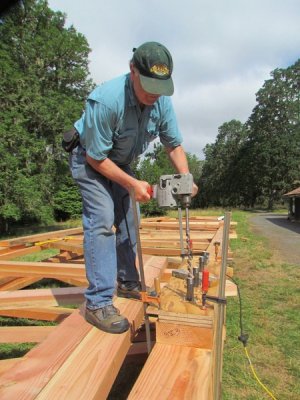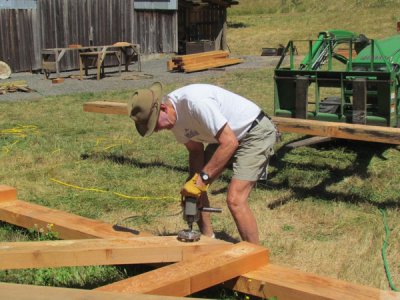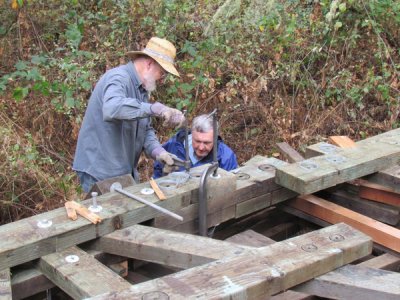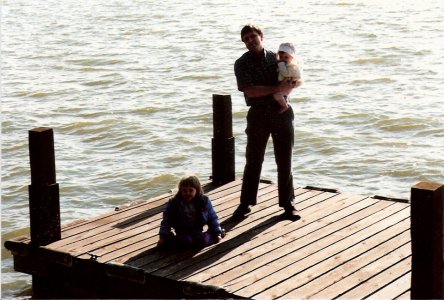- Joined
- May 6, 2012
- Messages
- 116
I hike quite a bit on a mountain called Mt. Pisgah. Mt Pisgah is a non-profit organization that maintains over 75 acres with over 16 miles of trails on a shoestring, donated budget.
At a fund raising event I was talking with the manager and offered to volunteer to help on some limited project. Brad said there was an upcoming bridge project and I anticipated a 20 ft. bridge over one of the small streams. "I think I can do that," I responded.
Well, it didn't turn out to be 20'. Here is the bridge project, all 86ft. of it. I worked almost continuously six to seven days per week for four weeks with one to three volunteers on building the bridge. Below is level one. It was built on a grassy slope (somewhat short of ideal conditions) with the bottom laid out.
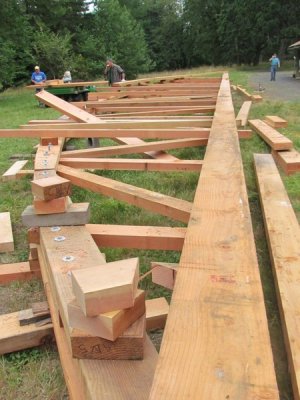

We started with some of the nicest donated fir lumber. The logs were milled at a steam driven mill in Philomath, Oregon. I missed this part, unfortunately. When I arrived on the scene there were a set of engineer/architect plans and that was it. Having a construction background I pitched in and we started from a stack of lumber.
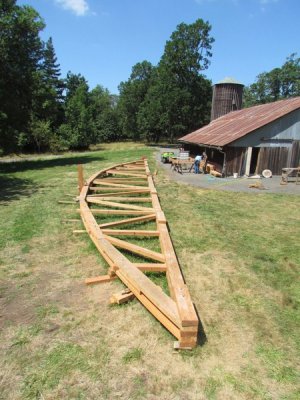

Above shows one side completed. A second side was assembled on top. All holes were drilled and all pieces were labeled and off it went to be pressure treated.
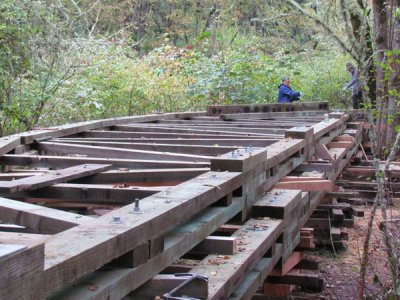

The pressure treating took longer than we thought because it had to be a specially run batch and the wood had to be then kiln dried to prevent the chemicals from leaching into the pond. Back from pressure treating the bridge was assembled adjacent to the pond it was to span. This was a more remote area with a steeper slope. Notice the color change with the pressure treating. I am in the background.
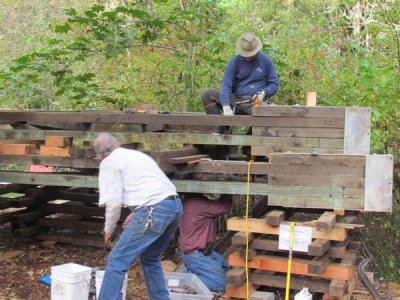

It is a real challenge working with part time volunteers. Fortunately, a friend of mine returned from his months in Europe to help out (on top). I drew the bottom position here attaching the shoes on the ends of the bridge trying to get the holes to line up.
Notice the cribbing supporting the stacked sides. The other end was flat with the ground. We periodically had to level the whole thing as the cribbing was slowly sinking in the mud of the encroaching Oregon winter rains.
Our next job to start this summer (June) is to have a crane lift the two sides, stabilize it and attach the cross bracing and decking.
Jim



At a fund raising event I was talking with the manager and offered to volunteer to help on some limited project. Brad said there was an upcoming bridge project and I anticipated a 20 ft. bridge over one of the small streams. "I think I can do that," I responded.
Well, it didn't turn out to be 20'. Here is the bridge project, all 86ft. of it. I worked almost continuously six to seven days per week for four weeks with one to three volunteers on building the bridge. Below is level one. It was built on a grassy slope (somewhat short of ideal conditions) with the bottom laid out.

We started with some of the nicest donated fir lumber. The logs were milled at a steam driven mill in Philomath, Oregon. I missed this part, unfortunately. When I arrived on the scene there were a set of engineer/architect plans and that was it. Having a construction background I pitched in and we started from a stack of lumber.

Above shows one side completed. A second side was assembled on top. All holes were drilled and all pieces were labeled and off it went to be pressure treated.

The pressure treating took longer than we thought because it had to be a specially run batch and the wood had to be then kiln dried to prevent the chemicals from leaching into the pond. Back from pressure treating the bridge was assembled adjacent to the pond it was to span. This was a more remote area with a steeper slope. Notice the color change with the pressure treating. I am in the background.

It is a real challenge working with part time volunteers. Fortunately, a friend of mine returned from his months in Europe to help out (on top). I drew the bottom position here attaching the shoes on the ends of the bridge trying to get the holes to line up.
Notice the cribbing supporting the stacked sides. The other end was flat with the ground. We periodically had to level the whole thing as the cribbing was slowly sinking in the mud of the encroaching Oregon winter rains.
Our next job to start this summer (June) is to have a crane lift the two sides, stabilize it and attach the cross bracing and decking.
Jim

